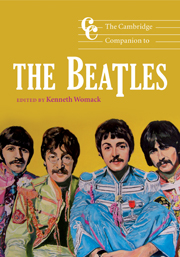1 - Six boys, six Beatles: the formative years, 1950–1962
from Part I - Background
Published online by Cambridge University Press: 28 September 2011
Summary
The starting point of critical elaboration is the consciousness of what one really is, and is “knowing thyself” as a product of the historical process to date which has deposited in you an infinity of traces, without leaving an inventory. Therefore it is imperative at the outset to compile such an inventory.
antonio gramsciIntroduction
The chapter deals with the formative years of both the Beatles and the six youths who were group members in the late 1950s and early 1960s, including Stuart Sutcliffe and Pete Best, who left the band in 1961 and 1962 respectively. Although it cannot claim to be a complete inventory (to borrow a term from Gramsci in the quotation above), it is intended to present the boys and the band as products of the historical process in the England of the 1950s through the presentation of some of the “infinity of traces” deposited in them by that historical period.
In this account of the dual formation of the group and the six individuals, I will discuss first the various networks within which the six were enmeshed as children, adolescents and young men: those of the family and social class, of the school and youth culture peer group. The second part of the chapter describes and analyses the musical factors and features that coalesced to form first the Quarrymen skiffle group and then the early Beatles.
The data upon which this chapter is based are drawn from published biographies and autobiographies. These publications are of three types: authorized biographies such as those of Shepherd, Davies, Miles, and the Beatles “themselves”; unauthorized biographies such as Goldman's, Connolly's, and Sullivan's psychoanalytical volume; and the memoirs of colleagues, friends, and family such as Epstein, Cynthia Lennon, and Pauline Sutcliffe. The overall quality of this material is uneven, with a number of errors and discrepancies that have confused the general understanding of the early years of the Beatles.
- Type
- Chapter
- Information
- The Cambridge Companion to the Beatles , pp. 7 - 32Publisher: Cambridge University PressPrint publication year: 2009



